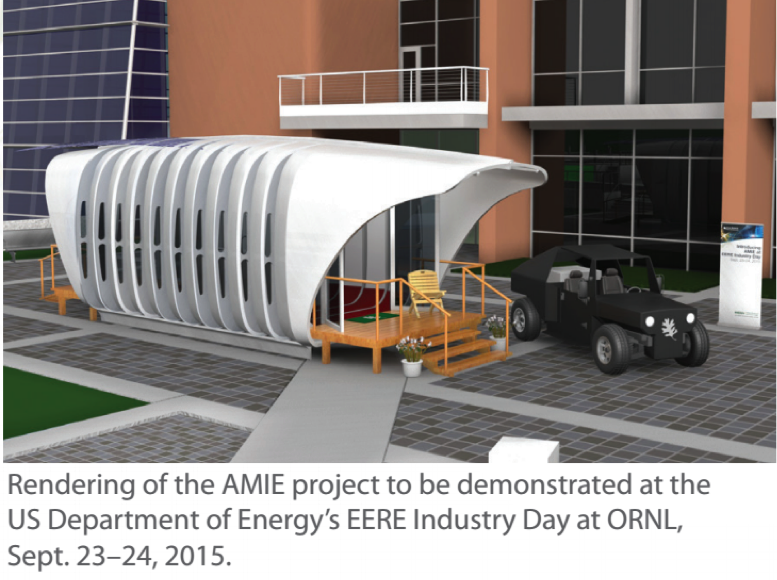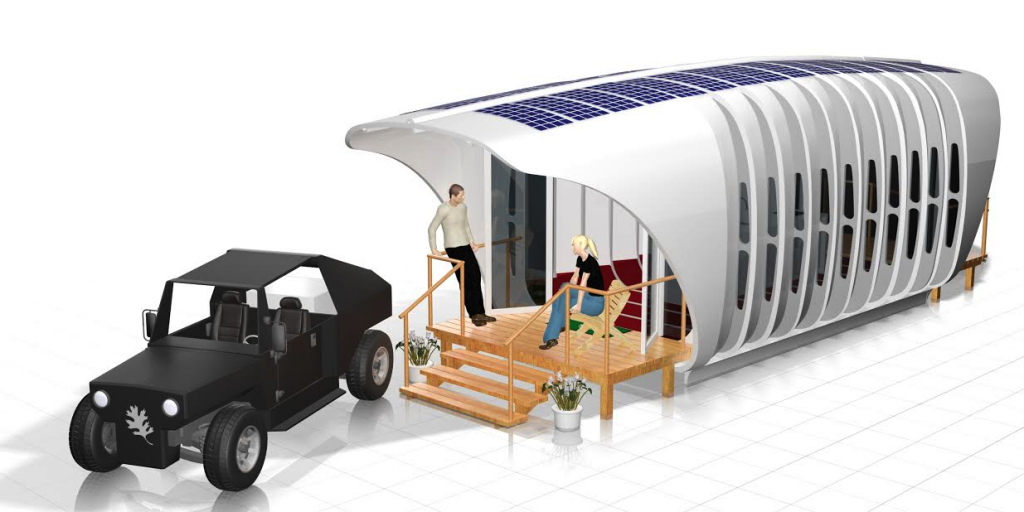 After two years of covering news related to the 3D printing industry, it’s very seldom that I get overly excited about a particular story or a project. With that said, after a thirty minute conversation with Roderick Jackson, Head of Building Envelope Systems Research at Oak Ridge National Laboratory (ORNL), I came away thoroughly excited about a project that they are working on and set to unveil in late September.
After two years of covering news related to the 3D printing industry, it’s very seldom that I get overly excited about a particular story or a project. With that said, after a thirty minute conversation with Roderick Jackson, Head of Building Envelope Systems Research at Oak Ridge National Laboratory (ORNL), I came away thoroughly excited about a project that they are working on and set to unveil in late September.
Most of you are likely familiar with the work that ORNL has been doing within the additive manufacturing space. In fact, the world’s first 3D printed car by Local Motors relied heavily on the advanced manufacturing techniques and material science pioneered at the ORNL facilities. In particular the laboratory uses a 3D printer called BAAM, which they teamed up with Cincinnati Inc. to construct. BAAM, and its more recently unveiled larger version, can print giant structures very rapidly. In fact, the latest machine is able to output up to 100 pounds of material every hour and print objects as large as 20 x 12 x 6 feet in size.
So what exactly is it that has me so excited? How about an an integrated approach to electricity generation, storage, and consumption via a 3D printed energy-efficient home along with a new 3D printed car which systematically work together to share energy wirelessly?
ORNL has partnered with the largest manufacturer of manufactured housing and modular homes in the United States, Clayton Homes, along with the American architectural firm Skidmore, Owings & Merrill (SOM) and has been working on this Additive Manufacturing Integrated Energy (AMIE) project since it was first conceptualized back in October of last year.
“We gave them [Clayton Homes and SOM] the tools, we worked with them and we developed this building design that fully demonstrates what happens when you remove the constraints, and allow construction practices to come into the 21st century,” Jackson explained to 3DPrint.com. “So now we are not running into the corners, where sticks and boards are constraints, but we can put curves where we want curves to be and we can put material where we want material. When we see structure is needed we can add material, so now we can reduce the overall material needed to build.”
There have been several groups and companies we’ve covered over the last couple of years who are working on methods of printing homes and buildings. However, this project strays wildly from them all. For one, both the home and the vehicle will be printed out of a carbon fiber-reinforced polymer material similar to that which was used in Local Motors’ 3D printed Strati car last year. Additionally, the home will have a bi-directional energy relationship with the 3D printed car.
“We will have a vehicle that not only is able to draw power from the building but is able to share power with the building. Now when the building needs power it [the vehicle] can provide that with its on-board natural gas generator and when the battery is low in the car, the building can charge the car. It’s a bi-direction flow of energy,” Jackson explained.
Not only that but all this will happen wirelessly via a coupling between a special pad and the vehicle. The vehicle would run on electricity, but is a hybrid with a natural gas generator. This generator would extend the vehicle’s range while it can also be used to provide wireless power to the home when it’s parked beside it. At the same time the home, which utilizes a 3.2 kW solar photovoltaic system, and features integrated low-cost vacuum insulated panels, would be able to charge the vehicle with its excess energy. The entire platform features an automatic control system to optimize the flow of energy between the car, the battery, solar panels and the grid, and its design uses advanced building control and power management strategies.
“What we are trying to do is actually start the discussion on what if we did a radical version of 3D printing a building, and what if we used additive manufacturing to look at the integrations of the vehicle and the building and the grid, which optimizes resources for all,” Jackson told us. “If you are going to use additive manufacturing to do the kinds of things that you can already do in building today you’ve kind of missed the mark. We want to use additive manufacturing to do things we can not do in building today.”
 Through the use of 3D printing, the project has been incredibly efficient allowing those working on it to quickly discuss, print, and integrate upon ideas. In fact, Jackson tells us that over the course of a single week they have been able to reduce both the time and the material required for this project by a staggering 40%.
Through the use of 3D printing, the project has been incredibly efficient allowing those working on it to quickly discuss, print, and integrate upon ideas. In fact, Jackson tells us that over the course of a single week they have been able to reduce both the time and the material required for this project by a staggering 40%.
At this time the home is currently under construction. It is being printed in several large sections and then assembled within the Clayton Homes facility. At the EERE Industry Day on September 23 ORNL, along with Clayton Homes, will be unveiling this awesome platform, one which we will certainly be covering again soon.
The future of home building lies in energy efficiencies and working with the latest technologies to reduce the carbon footprint of both homes and vehicles alike, as well as save their users money over the long run. Certainly this integrated platform will act as a springboard for future concepts within home construction, energy conservation and car manufacturing.
Let us know your thoughts on this awesome project by ORNL, Clayton Homes, and SO&M. Could this be the future of energy efficiency? Discuss in the 3D Printing Energy Sharing Home and Car forum thread on 3DPB.com.
Subscribe to Our Email Newsletter
Stay up-to-date on all the latest news from the 3D printing industry and receive information and offers from third party vendors.
You May Also Like
Air Force Awards Fortius Metals $1.25M to Qualify 3D Printing Wire for Hypersonic Applications
AFWERX, part of the US Air Force Research Laboratory (AFRL), awarded a Direct-to-Phase II Small Business Innovation Research (SBIR) contract worth $1.25 million to Colorado’s Fortius Metals, to accelerate qualification...
US Air Force Awards JuggerBot $4M for Large-format Hybrid 3D Printing
Large-format 3D printer manufacturer JuggerBot has received a $4 million grant to develop a large format 3D printer, courtesy of the Under Secretary of Defense, Research and Engineering Manufacturing Technology...
Where Have All AM’s Unicorns Gone?
In the rapidly evolving world of 3D printing, startups valued at over a billion dollars, known as unicorns, once seemed as fantastical as the mythical creatures themselves. While a few...
How My Childhood Fascination with Planes Led to Investing in 3D Printing
My fascination with aerospace started young, and I started studying planes–identifying them in the sky and learning everything I could about how they work. Fast forward to my first week...

































